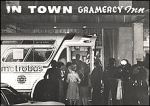13 August 2007
'Some Things You Never Forget'
 Thirty years ago, gunmen stormed three D.C. buildings, taking 150 hostages and one life. Today the city remembers that terrifying hint of things to come.
Thirty years ago, gunmen stormed three D.C. buildings, taking 150 hostages and one life. Today the city remembers that terrifying hint of things to come.
The small scar above Marion Barry's heart has had three decades to fade, but it's still noticeable -- evidence that some things don't disappear with time. For 39 hours in March 1977 -- before the word "terrorism" entered our daily vocabulary -- 12 gunmen paralyzed the District in a three-point siege. The group of Hanafi Muslims held about 150 people hostage in three buildings, and before they surrendered, a young reporter was killed and dozens were injured, including D.C. Council member Barry. A shotgun pellet pierced his chest, right above his heart, nearly killing him. Hostages who were held by gunmen at the B'nai B'rith International Center board a bus after their release. The March 1977 siege by a group of Hanafi Muslims lasted 39 hours and ended with one person dead and dozens hurt. (1977 Associated Press Photo) Who's Blogging? Read what bloggers are saying about this article. Weasel Zippers Terrierman's Daily Dose Something... and Half of Something Full List of Blogs (18 links) » Most Blogged About Articles On washingtonpost.com | On the web Save & Share Article What's This? DiggGoogle del.icio.usYahoo! RedditFacebook "It's been a long time, but some things you never forget. And that's one of them," Barry said in an interview Friday. This morning, many who remember those three days and others who simply recognize their significance will gather in the Wilson Building's fifth-floor press room. They will unveil two plaques and dedicate the room to Maurice Williams, the WHUR-FM radio reporter who was shot as he stepped off an elevator in the District Building, the name of the city government's headquarters at the time. The building was one of the three places targeted in the siege, along with the B'nai B'rith International Center, at the time on Rhode Island Avenue NW, and the Islamic Center, on Massachusetts Avenue NW. "I believe this incident was one of the more traumatic incidents in the history of this city, and the fact that he was the only African American journalist ever killed in the line of duty . . . makes it a very special occasion," Paul Brock, who was WHUR's news director when Williams was a student intern, said yesterday. Brock will be among those gathered. "It's an incident that everyone should know about," he said. "It was a hint of things to come." The siege started March 9, 1977, at a time when security was still relaxed in government buildings and hostage videos weren't a few clicks away on the Internet. It was before people searched mail for white powder or suicide bombings claimed regular headlines. "This was an early wake-up call about violence and terrorism and the extent to which groups will go to engage in violence either for the sake of violence or to make a point," Daniel S. Mariaschin, executive vice president of B'nai B'rith International, said yesterday. "Little did we know 30 years ago that this kind of issue would be a daily concern for all of us, not only here in Washington but abroad as well." He will speak at today's event. The 12 gunmen had several demands. They wanted the government to hand over a group of men who had been convicted of killing seven relatives -- mostly children -- of takeover leader Hamaas Abdul Khaalis. They also demanded that the movie "Mohammad, Messenger of God" be destroyed because they considered it sacrilegious. Most of the hostages, more than 100, were captured at the B'nai B'rith headquarters. Rae Ehrlich, a secretary on the fourth floor of the Jewish organization's building at the time, was among those held captive. POSTED BY/http://www.washingtonpost.com
18:15 Posted in UNITED STATES | Permalink | Comments (0) | ![]() Facebook |
Facebook |



















The comments are closed.